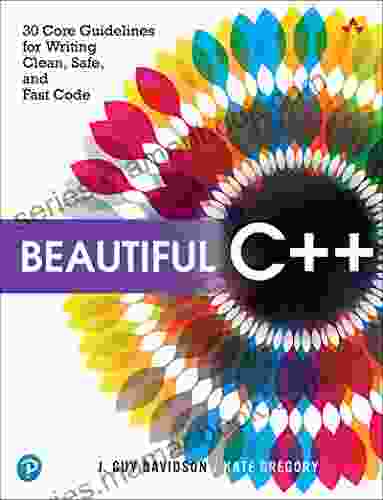30 Core Guidelines for Writing Clean, Safe, and Fast Code

In the realm of software development, code quality plays a pivotal role in determining the success and longevity of an application. Clean, safe, and fast code is not merely a desirable attribute; it is an indispensable foundation for building robust, efficient, and maintainable software systems.
4.7 out of 5
| Language | : | English |
| File size | : | 12775 KB |
| Text-to-Speech | : | Enabled |
| Enhanced typesetting | : | Enabled |
| Print length | : | 352 pages |
| Screen Reader | : | Supported |
Adhering to a set of well-defined guidelines can significantly enhance code quality. This article presents a comprehensive list of 30 core guidelines that can help developers write code that is:
- **Clean:** Easy to read, understand, and maintain
- **Safe:** Free from vulnerabilities and errors
- **Fast:** Optimized for performance and efficiency
Core Guidelines
1. Maintain Clean and Consistent Naming Conventions
Use meaningful and consistent names for variables, functions, classes, and other code elements. Avoid using generic or cryptic names that can make code difficult to understand.
2. Follow a Consistent Coding Style
Establish a set of coding standards and ensure that all team members follow them. This includes guidelines for indentation, spacing, and code formatting.
3. Use Self-Documenting Code
Write code that is self-explanatory. Use descriptive variable names, clear function names, and inline comments to provide context and explain the purpose of code.
4. Favor Simple and Readable Code
Aim for simplicity and readability. Break down complex code into smaller, manageable chunks. Avoid excessive nesting and複雑な構文.
5. Utilize Code Reusability
Identify opportunities to reuse code instead of duplicating it. Create reusable functions, classes, or components that can be used in multiple places.
6. Eliminate Redundancy
Review code for any redundant or unnecessary code. Remove unnecessary conditions, loops, and variables that do not contribute to the program's logic.
7. Test Early and Often
Implement frequent testing throughout the development cycle. Write unit tests to verify the correctness of individual code units and integration tests to ensure that different components work together seamlessly.
8. Handle Exceptions Gracefully
Anticipate and handle exceptions gracefully. Use try-catch blocks to catch and handle errors in a controlled manner, preventing the program from crashing.
9. Validate User Input
Validate user input to prevent malicious attacks or invalid data. Use input validation techniques to check for proper data types, ranges, and formats.
10. Escape Special Characters
When displaying user input or data from an untrusted source, escape special characters to prevent cross-site scripting (XSS) and other security vulnerabilities.
11. Use Secure Coding Practices
Follow secure coding practices to prevent buffer overflows, SQL injections, and other security vulnerabilities. Use libraries and tools that support secure coding techniques.
12. Optimize for Performance
Identify and eliminate performance bottlenecks. Profile code to identify areas that need optimization. Use efficient algorithms and data structures.
13. Avoid Over-Optimization
While optimization is important, avoid over-optimizing code. Premature optimization can lead to unnecessary complexity and decreased readability.
14. Use Memory Management Techniques
Manage memory efficiently to avoid memory leaks and excessive memory consumption. Use appropriate memory management techniques such as garbage collection or reference counting.
15. Optimize for Space
In resource-constrained environments, optimize code for space efficiency. Use techniques such as code compression, code stripping, and removing unnecessary data.
16. Favor Concurrency over Multithreading
In multithreaded environments, favor concurrency over multithreading for better performance and maintainability. Use synchronization primitives correctly to prevent race conditions and other threading issues.
17. Use Thread-Safe Data Structures
When using multithreading, use thread-safe data structures to ensure that data is not corrupted by multiple threads accessing it concurrently.
18. Write Concurrent Code Defensively
Assume that concurrent code can be executed in any order. Write code that is robust and handles potential race conditions and data corruption.
19. Use Error Handling Best Practices
Implement error handling best practices by using exceptions, error codes, or logging mechanisms. Provide clear error messages to aid in debugging.
20. Log Exceptions and Errors
Log exceptions and errors to a central location for easy identification and troubleshooting. Use logging frameworks to log error messages in a structured and standardized format.
21. Use Version Control
Use version control systems to track changes to code and facilitate collaboration among team members. Regularly commit changes and create branches for new features or bug fixes.
22. Refactor Code Regularly
Refactor code regularly to improve its structure, readability, and maintainability. Identify and eliminate code duplication, simplify complex code, and extract common functionality into reusable components.
23. Use Continuous Integration
Implement continuous integration (CI) to automate code builds, testing, and deployment. CI helps ensure that code changes do not break the build or introduce errors.
24. Perform Code Reviews
Conduct code reviews regularly to identify potential issues, improve code quality, and share knowledge among team members.
25. Follow Best Practices for Code Documentation
Write thorough and up-to-date documentation for your code. Use documentation tools to generate API documentation, tutorials, and other resources that aid in understanding and using the code.
26. Use Code Analysis Tools
Utilize code analysis tools to identify potential code issues, such as security vulnerabilities, performance bottlenecks, or coding style violations.
27. Stay Updated on Software Development Best Practices
Continuously learn about and adopt software development best practices. Attend conferences, read technical blogs, and participate in online communities.
28. Share Knowledge and Learn from Others
Share your knowledge with others by writing blog posts, giving presentations, or mentoring junior developers. Learn from the experiences and insights of others in the software development community.
29. Practice Code Kata
Engage in code kata exercises to improve your coding skills and problem-solving abilities. Regular practice helps you develop a deeper understanding of code and best practices.
30. Build Quality into the Development Process
Make code quality a top priority throughout the development process. Establish a culture of quality and empower developers to take ownership of code quality.
By adhering to these 30 core guidelines, developers can write clean, safe, and fast code that is easy to read, understand, maintain, and reuse. These guidelines provide a solid foundation for building robust, efficient, and secure software systems that stand the test of time. Remember, the pursuit of code quality is an ongoing journey, requiring continuous effort and dedication.
4.7 out of 5
| Language | : | English |
| File size | : | 12775 KB |
| Text-to-Speech | : | Enabled |
| Enhanced typesetting | : | Enabled |
| Print length | : | 352 pages |
| Screen Reader | : | Supported |
Do you want to contribute by writing guest posts on this blog?
Please contact us and send us a resume of previous articles that you have written.
 Top Book
Top Book Novel
Novel Fiction
Fiction Nonfiction
Nonfiction Literature
Literature Paperback
Paperback Hardcover
Hardcover E-book
E-book Audiobook
Audiobook Bestseller
Bestseller Classic
Classic Mystery
Mystery Thriller
Thriller Romance
Romance Fantasy
Fantasy Science Fiction
Science Fiction Biography
Biography Memoir
Memoir Autobiography
Autobiography Poetry
Poetry Drama
Drama Historical Fiction
Historical Fiction Self-help
Self-help Young Adult
Young Adult Childrens Books
Childrens Books Graphic Novel
Graphic Novel Anthology
Anthology Series
Series Encyclopedia
Encyclopedia Reference
Reference Guidebook
Guidebook Textbook
Textbook Workbook
Workbook Journal
Journal Diary
Diary Manuscript
Manuscript Folio
Folio Pulp Fiction
Pulp Fiction Short Stories
Short Stories Fairy Tales
Fairy Tales Fables
Fables Mythology
Mythology Philosophy
Philosophy Religion
Religion Spirituality
Spirituality Essays
Essays Critique
Critique Commentary
Commentary Glossary
Glossary Bibliography
Bibliography Index
Index Table of Contents
Table of Contents Preface
Preface Introduction
Introduction Foreword
Foreword Afterword
Afterword Appendices
Appendices Annotations
Annotations Footnotes
Footnotes Epilogue
Epilogue Prologue
Prologue Dale Strickler
Dale Strickler Erich Nunn
Erich Nunn Angela Duckworth
Angela Duckworth Marilyn Willis
Marilyn Willis Mahauganee D Shaw Bonds
Mahauganee D Shaw Bonds Alice Aspinall
Alice Aspinall Jp Robinson
Jp Robinson Garden Knits
Garden Knits Lesley Eames
Lesley Eames Tamara Kamenszain
Tamara Kamenszain Dennis Carstens
Dennis Carstens Erin Litteken
Erin Litteken Gary Smailes
Gary Smailes Mark Phillips
Mark Phillips Neel Majumder
Neel Majumder Byron Y Chen
Byron Y Chen Larry Swedroe
Larry Swedroe Marcus Samuelsson
Marcus Samuelsson Jeffery Deal
Jeffery Deal Joyce Farrell
Joyce Farrell
Light bulbAdvertise smarter! Our strategic ad space ensures maximum exposure. Reserve your spot today!

 Anthony BurgessRagnvald Hrolfsson: The Norman Conqueror Who Shaped the Course of Western...
Anthony BurgessRagnvald Hrolfsson: The Norman Conqueror Who Shaped the Course of Western... Ernest ClineFollow ·13.9k
Ernest ClineFollow ·13.9k Francisco CoxFollow ·5.1k
Francisco CoxFollow ·5.1k Gage HayesFollow ·18k
Gage HayesFollow ·18k Franklin BellFollow ·7.1k
Franklin BellFollow ·7.1k Mario SimmonsFollow ·12.8k
Mario SimmonsFollow ·12.8k Gary ReedFollow ·2.8k
Gary ReedFollow ·2.8k Devin CoxFollow ·4k
Devin CoxFollow ·4k Dakota PowellFollow ·10.8k
Dakota PowellFollow ·10.8k

 David Mitchell
David MitchellMy Surly Heart: Poetic Expressions of Unrequited Love...
In the annals of...

 Jake Carter
Jake CarterBleach Vol. 50: The Six Fullbringers - A Comprehensive...
Bleach Vol. 50, titled "The Six...

 Edward Reed
Edward ReedThe Art of Simple Food II: A Masterclass in Culinary...
In an era of culinary excess, where meals...

 Jarrett Blair
Jarrett BlairThe Easy Ingredient Ketogenic Diet Cookbook: Your Gateway...
The ketogenic diet,...

 Larry Reed
Larry ReedThe Very Edge Poems Polly Alice Mccann: A Poetic...
An to 'The Very...

 Sidney Cox
Sidney CoxThe Keys of Death and Hades: Unlocking the Epic of...
In the realm of mythology...
4.7 out of 5
| Language | : | English |
| File size | : | 12775 KB |
| Text-to-Speech | : | Enabled |
| Enhanced typesetting | : | Enabled |
| Print length | : | 352 pages |
| Screen Reader | : | Supported |










